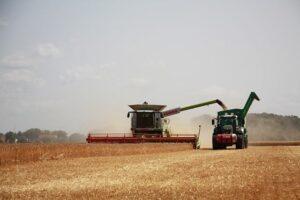The summer harvest is over
With the exception of a few small areas, the summer harvest ended by July 24, which was not significantly affected by the unfavorable circumstances this year. The warehouse capacity is sufficient to store the crops, most of this year’s harvest is already in the warehouses, said Zsolt Feldman.

(Photo: Pixabay)
According to the state secretary responsible for agriculture and rural development, the farmers should be thanked for their diligence and perseverance, because thanks to their dedicated work, new bread can be put on the tables of Hungarian families. According to Zsolt Feldman, this year’s summer harvest progressed at a good pace and ended with an average result compared to previous years. The decreasing tendency of the sown areas in terms of quantity was partly compensated by the relatively favorable yields for several plant species, the exception being autumn cabbage rape. Based on the information, the country’s supply of summer-harvested crops is ensured and a significant export commodity base of several million tons has been formed.
According to the data of the National Chamber of Agriculture, the harvest of winter wheat is practically finished, only a few small areas are left
In this year’s area of 864.5 thousand hectares, the national average yield is around 5.8 t/ha. This value slightly exceeds the yield averages of last year and the last five years. The highest averages (6.8 t/ha) were reported from Baranya, Tolna and Vas counties, the lowest (around 5 t/ha) from Pest, Nógrád and Bács-Kiskun counties. Based on the yields per hectare and the area, a total of nearly 5 million tons of wheat was produced this year, which more than covers the annual domestic consumption of around 3 million tons. The food-grade crop is also sufficient to meet the domestic annual grinding needs of around 1.1 million tons. Taking into account the current season’s domestic wheat prices, the value of the wheat used to produce 1 kilogram of bread does not exceed HUF 100, the state secretary pointed out.
The harvest of autumn barley was completed at the earliest
In comparison to previous years, a national yield of 5.7 t/ha was established in an area of 260,000 hectares, which is 3.7% higher than last year’s value and essentially the same as the average of the last five years. There are significant differences between the individual counties, and the yields per hectare show a very wide spread (from 5.1 t/ha to 6.7 t/ha). Transdanubia counties are typically more favorable, while Central Hungary and some Southern Great Plain counties produced weaker yields, which was largely caused by weather factors. The total autumn barley harvest is close to 1.5 million tons, which more than covers the annual approx. 1 million tons of domestic use. The harvest of spring barley, rye, oats and triticale is almost over. Based on the final data, the average yield for rye is 2.9 t/ha, for spring barley 4.7 t/ha, for triticale 4.3 t/ha, and for oats 3 t/ha, which largely correspond to the average of the past years of its values. Harvesting of the autumn cabbage rape has also been completed. The national average yield is around 2.5 t/ha. Among the crops sown in the fall, this year’s weather affected the fall cabbage rape the most. Due to the compound effect of the significantly lower area – 174 thousand hectares – compared to previous years and the lower yields per hectare than in previous periods, the total yield is around 432 thousand tons. The farmers also harvested seed peas, the national average yield in the 13,000-hectare area is 2.4 t/ha, but there is a significant variation between the individual counties.
AM
Related news
AM: Government helps farmers with a loan moratorium
🎧 Hallgasd a cikket: Lejátszás Szünet Folytatás Leállítás Nyelv: Auto…
Read more >More than 100 Hungarian farmers also demonstrated in Brussels
🎧 Hallgasd a cikket: Lejátszás Szünet Folytatás Leállítás Nyelv: Auto…
Read more >Hungarian champagne crowns the end-of-year holidays!
🎧 Hallgasd a cikket: Lejátszás Szünet Folytatás Leállítás Nyelv: Auto…
Read more >Related news
Christmas shock in commerce: for the first time, we can pay with bank cards in fewer places
🎧 Hallgasd a cikket: Lejátszás Szünet Folytatás Leállítás Nyelv: Auto…
Read more >Hungarian Confectionery Manufacturers Association: trends in 2025 and prospects for 2026
🎧 Hallgasd a cikket: Lejátszás Szünet Folytatás Leállítás Nyelv: Auto…
Read more >Most grocery chains will be open until noon on December 24th
🎧 Hallgasd a cikket: Lejátszás Szünet Folytatás Leállítás Nyelv: Auto…
Read more >






